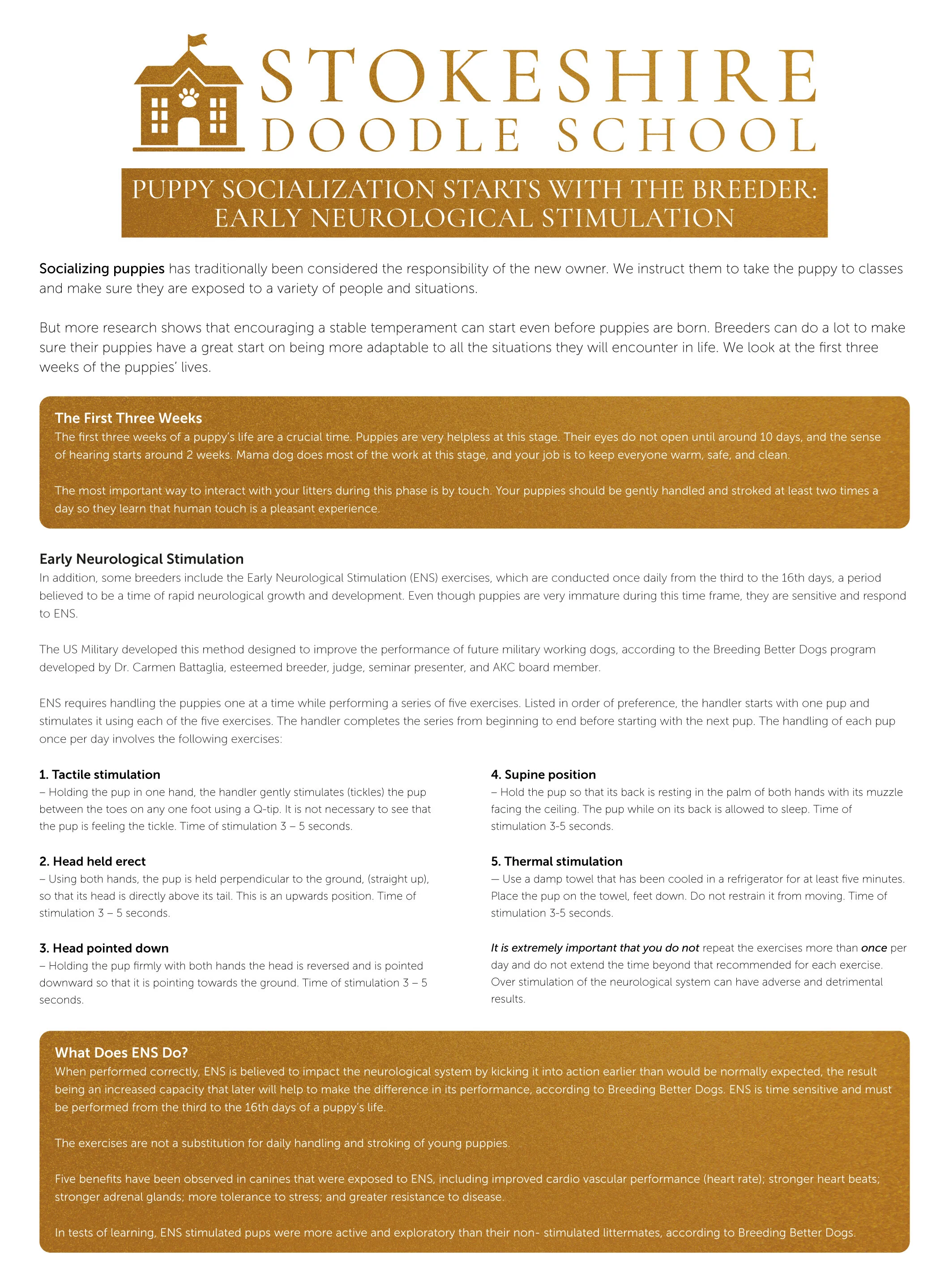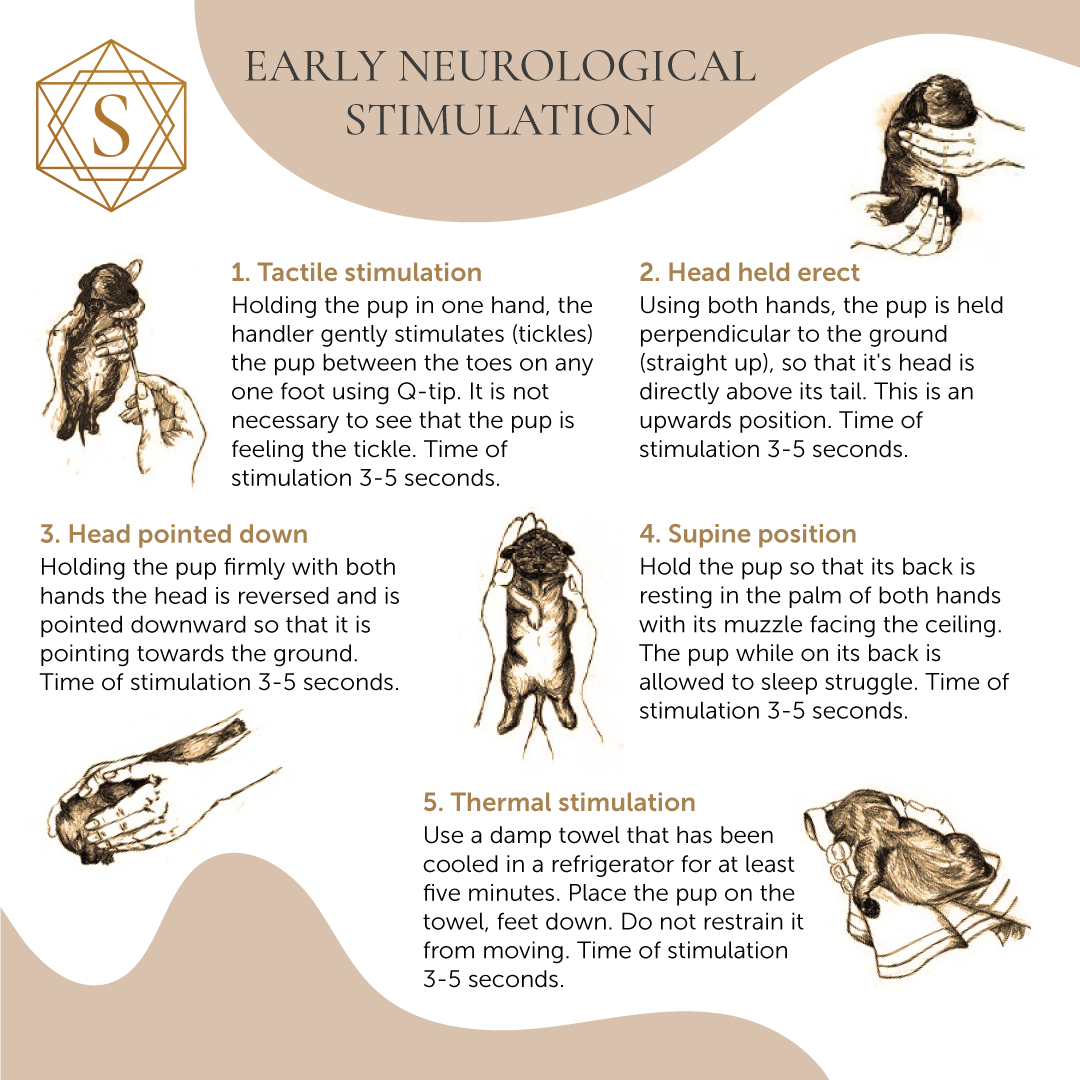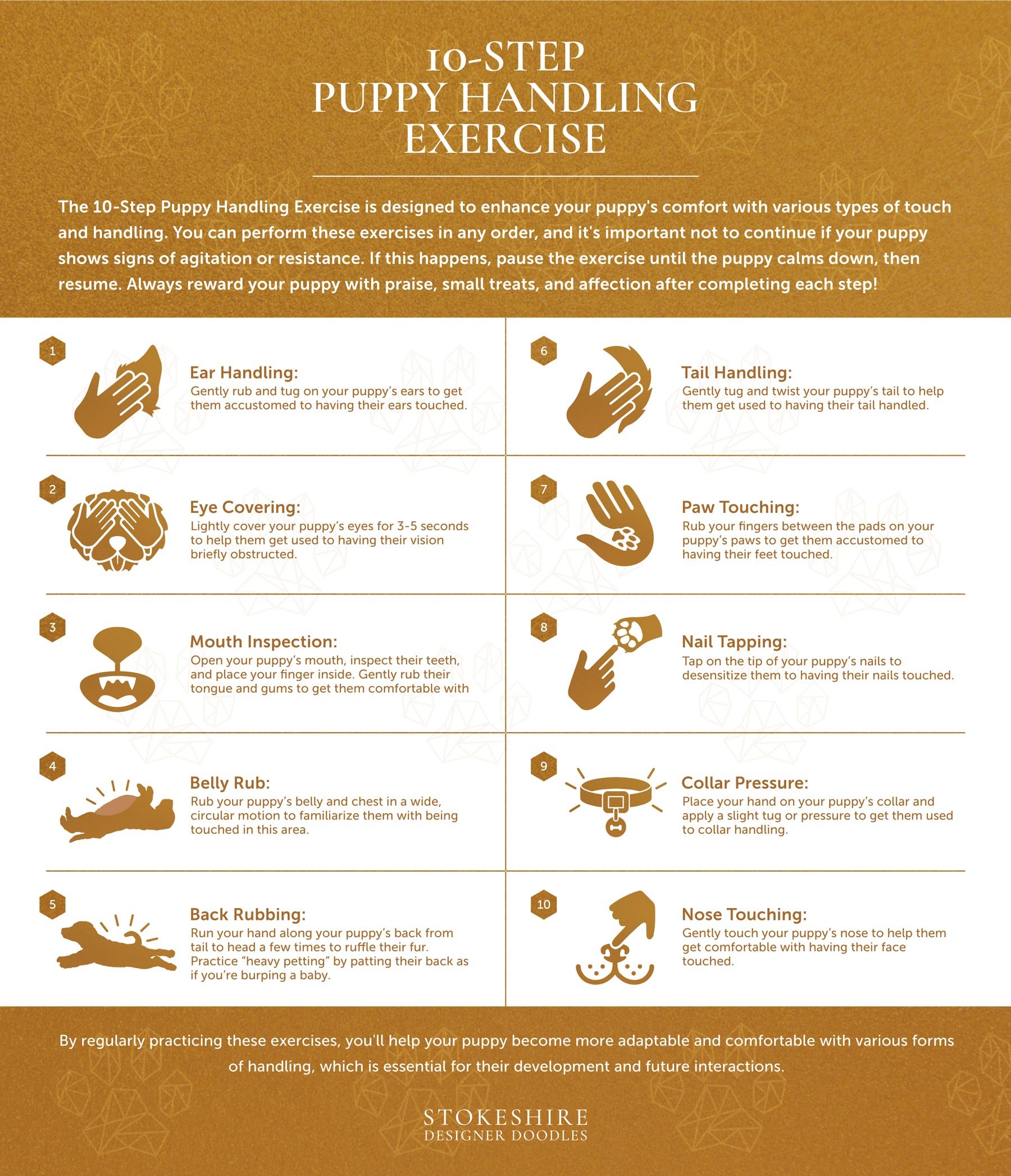(ENS) Early Neurological Stimulation & (ESI) Early Scent Introduction
(ENS) EARLY NEUROLOGICAL STIMULATION & (ESI) EARLY SCENT INTRODUCTION
Early neurological stimulation is a series of exercises that are designed to stimulate the neurological system of puppies during a critical period of their development, typically between the ages of 3 and 16 days. These exercises are believed to have a number of benefits, including enhancing the puppy's physical and mental development, improving their immune system function, and increasing their ability to cope with stress.
The specific exercises used in early neurological stimulation involve gently handling and manipulating the puppy's body in various ways, such as holding them in different positions, lightly tapping their paws and tail, and lightly stroking their coat. These exercises are typically performed once a day for a total of 5-10 minutes, and are believed to have a cumulative effect on the puppy's development.
It is important to note that early neurological stimulation should be performed by a trained and experienced professional and that the exercises should be gentle and not cause any distress or discomfort to the puppy. It is also important to follow the recommended guidelines for the exercises and to avoid overstimulating the puppy, as this can have negative effects on their development.
Early scent introduction is a method of introducing puppies to a variety of smells at a young age in order to expose them to a range of experiences and to help them become more confident and well-adjusted as they grow. This can involve introducing puppies to different types of surfaces, objects, and scents, such as grass, wood, metal, plastic, and various food and non-food items. The idea is to expose puppies to as many different smells and experiences as possible so that they can become comfortable with a wide range of stimuli and develop good problem-solving skills.
There are a few different ways to introduce puppies to new smells, depending on the specific needs and preferences of the individual puppies and their owners. Some common methods include:
Scent games: This involves hiding small treats or toys and allowing puppies to use their sense of smell to locate them. This can help puppies learn to use their sense of smell to find things and can also be a fun and engaging activity for both puppies and their owners.
Scent walks: This involves taking puppies on walks or hikes and encouraging them to explore and sniff their surroundings. This can help puppies become more comfortable with different types of smells and environments and can also help them develop their sense of curiosity and exploration.
Scent stations: This involves setting up a designated area with a variety of different objects and scents for puppies to explore and interact with. This can be a good way to expose puppies to a range of smells in a controlled and safe environment.
Overall, early scent introduction can be a useful tool for helping puppies develop good problem-solving skills and become confident and well-adjusted as they grow. It is important to remember, however, that every puppy is different and may have different needs and preferences, so it is important to tailor the approach to the individual puppy and to monitor their reactions and behavior.
Simple interactions early in a puppy’s life may increase its ability to learn and cope successfully with stress later on, thus leading to better welfare outcomes. Early Neurological Stimulation (ENS), which involves applying gentle stressors to a very young animal for short periods of time, is thought to improve their stress responses later in life. The stressors—which often include removing animals from their litters for short periods, very briefly exposing them to cool temperatures, holding them in different positions, and gently touching parts of their bodies—are applied for a few seconds, once a day, for at least 10 days.
The link between stress and activation of the endocrine system is well known. The release of glucocorticoids (a class of stress hormones) from the adrenal cortex following stress affects many processes in the body. These changes are the basis for the body’s “fight or flight” response. The effects of short-term, mild stress can be beneficial, creating “robustness” in the body and preparing it to deal more effectively with stressors later in life (Levine, 1960; and reviewed in Meaney, 2001; Pryce and Feldon, 2003). However, not all stress is equal. High-intensity or long-term stress is often detrimental, either because of overwhelming the body’s ability to respond, or leading to negative side effects from a sustained “fight-or-flight” process, which depletes energy and the ability to resist disease (Selye, 1956). Studies of ENS began with rat pups, and currently, most of the published work in this area is rodent focused. Rat pups handled early in life were much less fearful when exposed to an auditory stimulus (Schaefer, 1963), had lower corticosterone levels when restrained by a person (Plotsky and Meaney, 1993), and were less resistant to being captured after stress (Núñez et al., 1996). These findings have since generated interest in exploring the effects of ENS in other species, including dogs.
(ENS) EARLY NEUROLOGICAL STIMULATION & (ESI) EARLY SCENT INTRODUCTION
Early Neurological Stimulation (ENS) and Early Scent Introduction (ESI): Boosting Developmental Potential
Improved heart rate
Stronger heartbeats
Stronger adrenal glands
Better tolerance to stress
Greater resistance to disease
Applications and Effects of ENS on puppy development
As is the case for rodents, it is believed that ENS may provide stimulation to the developing puppy’s endocrine system and cause him/her to develop more ability to deal with stressful events later in life. This may lead to better learning and an improved ability to cope with adversity. Though some of this belief stems from the benefits of ENS shown in other species, it has also been advanced by unpublished work conducted as part of a US Military Working Dog (MWD) training program called “Bio Sensor,” later discussed by Battaglia (2009). Specific claims on the effects of “Bio Sensor” listed in Battaglia’s discussion include “improved” heart rate, “stronger” heartbeats and adrenal glands, and increased stress tolerance and disease resistance (Battaglia, 2009), although how these effects were measured was not specified. The “Bio Sensor” program exercises included the following:
Tactile Stimulation: the puppy is “tickled” between the foot pads on any one foot with a Q-Tip (3-5 seconds)
Head Erect: the puppy is held perpendicular to the ground with both hands, orienting its head above its tail (3-5 seconds)
Head Down: the puppy is held perpendicular to the ground with both hands, orienting its tail above its head (3-5 seconds)
Supine: the puppy rests with its back in the palms of both hands, with its nose oriented toward the ceiling (3-5 seconds)
Thermal Stimulation: a damp towel is placed in fridge for at least 5 minutes; place puppy on towel on all fours and do not restrain movement (3-5 seconds) Source: 2
Discover the key benefits of Early Neurological Stimulation (ENS) and Early Scent Introduction (ESI) for your puppy's development. ENS involves a series of structured activities that stimulate neural connections, enhance motor skills, accelerate learning abilities, and support emotional development. Meanwhile, ESI exposes puppies to various scents during critical stages of development, promoting sensory perception, aiding memory formation, and facilitating bonding between caregivers and puppies.
This comprehensive guide provides practical guidance on incorporating ENS and ESI into your daily routine, including various activities, exercises, and techniques that stimulate the senses and engage cognitive abilities. Drawing upon the expertise of renowned child development specialists and researchers, this guide also presents valuable insights and scientific findings related to ENS and ESI, highlighting the long-term impact of these techniques.
Invest in your puppy's future success by unlocking its potential through ENS and ESI. With step-by-step instructions and expert insights, parents and caregivers can confidently integrate these approaches into their puppy's early development journey, laying a strong foundation for academic success, social skills, and overall well-being.
To date, only a few studies have been conducted on ENS in dogs using various handling exercises, and these have shown variable results. For example, a study by Fox and Stelzner (1966) applied an ENS treatment that included exposure to light and sound, movement, cold, swimming, grooming, and a check of the puppy’s reflexes. The entire ENS treatment took one hour per puppy and was done daily from day one to 5 weeks of age. After three weeks, 10 minutes of play with the researcher was added in. Puppies were weighed and their heart rates were measured weekly. They were then behaviorally tested at 5 weeks, and the body weights, heart rates, and reflexes of ENS puppies were compared with those who did not receive ENS treatment. Handled puppies explored more, were more social toward humans and more confident when engaged in a social situation with other dogs. They also were better at problem-solving. They had increased heart rates compared to puppies that did not receive ENS, but there were no differences in their weights or reflexes (Fox and Stelzner, 1966). Another study looked at the effects of ENS on dogs being raised in homes and those kept in professional breeding kennels. The ENS consisted of a 5-minute gentle whole-body massage with the puppy lying both on its back and on its stomach (Gazzano et al., 2008). This was done daily for days 3-21 of life. The puppies were later behaviorally tested at 8 weeks of age. Handled and unhandled puppies from both the kennels and the homes were compared. In an isolation test, all handled puppies regardless of housing explored the environment more. There were no differences between any groups in their heart rates or reactions to different objects and an unfamiliar environment and person (Gazzano et al., 2008).
SOURCE: 1
What is ESI?
ESI stands for Early Scent Introduction. Early Scent Introduction is performed in conjunction with Bio-Sensor training on the puppies from day three through day sixteen. A pungent scent is introduced to the puppy each day for short intervals. Their reaction to the scent is recorded. A positive reaction is when a puppy will try to move towards the scent with their nose highly engaged in the scent. A negative reaction will have the puppy pulling back from the scent. A neutral reaction will be when the puppy does not seem interested or disinterested.
The benefits of ESI have been studied in a seven-year breeding test. Gayle Watson Ph.D. conducted the test with Gaylan’s Golden Retriever litters. They compared the litters to the dogs that had early scent detection and those that did not. She began her testing by looking at results from sporting Golden Retrievers here in the United States. Gayle and her team charted the outcome of various events to determine the effect the ESI had on the pups. They discovered the dogs introduced to ESI had increased scenting titles. In addition, these dogs were earning titles in more complex scenting categories. Dogs achieving these titles were two and a half to five years younger than those who did not have ESI. Our focus is to produce therapy-grade companions for families and facilities. ENS and ESI are part of our comprehensive Stokeshire Puppy Protocol as Empowered Breeders.












